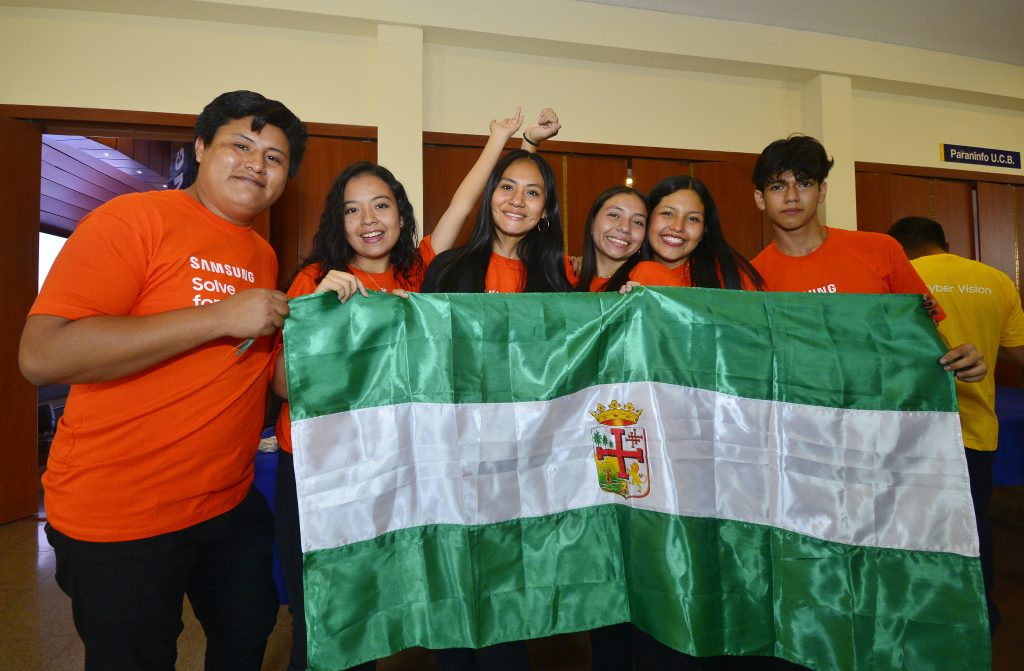Other than just passing tests to move up a grade, school can be a creation center for the benefit of society. And this is possible to encourage by promoting STEM (Science, Technology, Engineering, and Mathematics) projects focused on social inclusion. That’s what the team behind the “Focus” project did. They created an assistive technology device aimed at improving the quality of life for people with disabilities. The innovation is a kind of smartwatch that helps people with low or no vision, to move around more safely and easily.
The device helps users find specific locations and to avoid obstacles using voice commands. The project won the Popular Vote in Solve for Tomorrow Bolivia 2024 and was implemented in Santa Cruz de la Sierra, the country’s most populous city. Five students from the fourth year of secondary school took part — the penultimate year of compulsory schooling. Their mentor was Juan Juaniquina, a mathematics teacher for other grades, who had also taught them in the past — which is why they sought him out when preparing for Solve for Tomorrow.
The school they attend, part of the Unión Fe y Alegría network, is committed to educating students in scientific knowledge alongside human values, aiming to form people capable of understanding and interpreting today’s society. Familiar with such topics, when the team decided to develop a project for Solve for Tomorrow, they planned to design a device focused on people with visual impairments.
The first step, during the Empathy stage of the project journey, was to analyze the pros and cons of assistive technology. “All of us had already encountered people with visual impairments in our lives — whether family members, friends, or neighbors. So, we shared personal experiences. I myself lived with a blind person, and I witnessed the limitations they faced daily,” recalls the teacher.
But those outside perspectives were not enough. They turned to a local institution that works with this community to deepen their knowledge. In their conversations, they reflected on the various ways someone might become visually impaired — either genetically or through accidents — and the different degrees of vision loss. “I think what impacted us most were the stories of sudden vision loss. People described how they felt their freedom slipping away and how they didn’t want to become a burden to their families,” the teacher remembers.
They also discovered that although assistive devices exist to help with mobility and independence, they are not widely accessible in Bolivia. Moreover, local urban planning is rarely inclusive — with uneven streets and little tactile signage, for instance.
Talking to people with visual impairments was essential. We slowly brainstormed together about what features could or couldn’t work, adds Juaniquina.
Challenges in creating the assistive technology
In the end, the prototype was designed to ensure a good user experience. A watch is practical, worn on the body, and unlikely to get lost or stolen. It includes four analog buttons: two for volume control, one for activating voice commands, and another for sharing the user’s location for safety. The buttons have Braille inscriptions so users can understand the commands through touch.
A Braille teacher from the partner institution supported the Braille writing and suggested valuable improvements, such as replacing letters with recognizable symbols like a microphone. Samsung mentors, in turn, provided guidance in engineering and helped with selecting the right materials. The team also consulted programming experts to refine the technical aspects. However, due to limited access to electronic components in their region, the device remained in an analog version.On the other hand, the system software was developed and tested. They used a free application called App Inventor — intuitive and easy to use. The next step in completing the prototype would be to connect Arduino boards, sensors, and a GPS module to the watch and to integrate it with the software.

Presenting the project to the world
Throughout the project, the students actively used social media. First, to share information and raise awareness about the inclusion of people with visual impairments. Later, they launched a virtual and in-person mobilization campaign that helped them win the Popular Vote in Solve for Tomorrow Bolivia. They spoke to everyone they knew, visited classrooms to ask for support, and had help from a partner organization.
The entire experience helped the students develop soft skills, such as public speaking and team organization. “None of us ever expected to be part of a program like this, trying to program something. Our school doesn’t offer programming classes — it was all new. We learned together and realized that to make it work, we needed patience and close attention to each step,” says Juaniquina.




